Baking Potatoes: The Air Fryer Vs Oven Dilemma
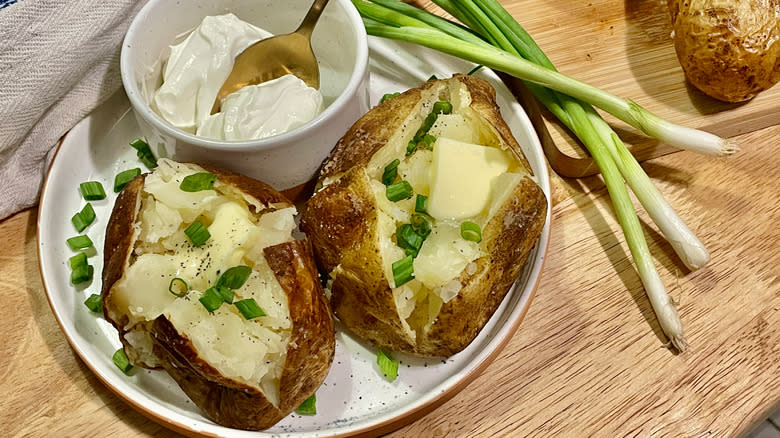
Of all the ways to cook a potato, a baked potato is one method with little room for shortcuts if you're looking for that perfectly crispy skin and tender potato filling. The traditional oven-baked method typically takes about an hour, which is asking a lot when you're already hungry and ready for dinner as soon as humanly possible. The microwave method cooks potatoes in a fraction of the time, but the skins are usually much softer in comparison to the oven-baked method. Some have looked for ways to microwave and bake their potatoes to achieve a crispy potato skin with less cooking time, but using multiple appliances can be a hassle when you're cooking other dishes too.
Then along came the air fryer, promising the crispy foods of your dreams without using loads of cooking oil and in less time than it would take to bake in a conventional oven. But how does a baked potato cooked in an air fryer stack up to one baked in a traditional oven? We grabbed a handful of russet potatoes and put our appliances to the test, paying special attention to the cooking time as well as prep time, flavor, texture, convenience, and clean-up. We also compared how long it might take to cook an entire meal, including potatoes, from beginning to end for just a few people (or a crowd) to determine which method is the best for your ultimate baked potato. This is everything we found along the way.
Read more: The Most Useless Cooking Utensils, According To Chefs
The Traditional Oven-Baked Potato Method
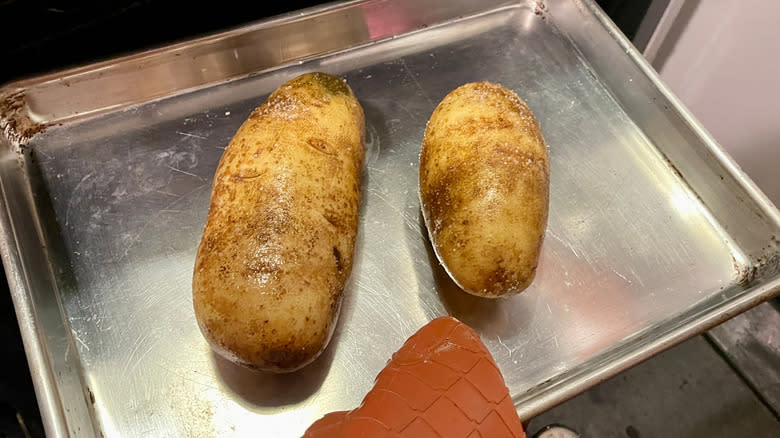
There is a wide range of suggestions for the correct baking temperature for potatoes — anywhere between 350 to 450 degrees Fahrenheit, with most recipes recommending 400 to 425 degrees. So we turned to the experts on potatoes for reliable guidance — none other than the Idaho Potato Commission (IPC). According to "Dr. Potato," the best temperature to cook potatoes at in a traditional non-convection oven is 400 Fahrenheit.
It can be hard to say for sure how long it will take a potato to cook with so many different potato sizes and cooking recommendations to consider. Generally speaking, you'll know if your potatoes are done if they're tender when pricked with a fork. But if your potato is on the larger side or unevenly shaped, the center may still be raw or undercooked without you realizing it until it's split all the way open. But one metric we can measure consistently is the internal cooking temperature, which the IPC recommends should reach 210 degrees Fahrenheit for a baked potato that you plan on serving and eating immediately.
When it comes to whether or not to wrap potatoes in aluminum foil to bake, we once again took the recommendation of the IPC and decided not to use foil. The method we settled on entails preheating the oven and baking sheet to 400 Fahrenheit, baking the potatoes until they reach the recommended temperature, and turning them over once around the 30-minute mark for even cooking.
The Air Fryer Baked Potato Method
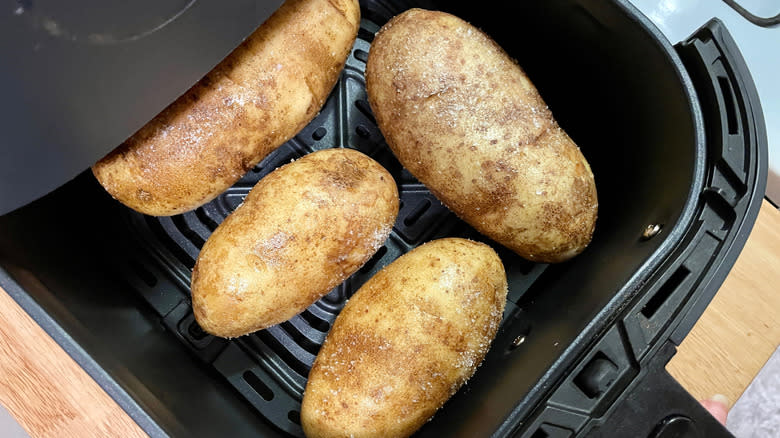
The IPC recommends setting your air fryer temperature to 400 to make baked potatoes, the same as a traditional oven — this has the additional benefit of helping to keep our tests consistent. Most recipes that we researched when preparing to test the baked potatoes also specify cooking potatoes in the air fryer at 400 Fahrenheit, so there's less confusion about what the correct cooking temperature actually is.
Regardless of the method used to cook your potatoes, you're still looking for the potatoes to reach an internal cooking temperature of 210 degrees. It's also not necessary to cook your potatoes in aluminum foil in the air fryer, especially if you're trying to achieve a lovely crispy potato skin from the baking process. We noticed that some air fryers have a pre-programmed "fries" setting, but that most likely won't get full-sized raw potatoes to the fully-cooked point. Instead, we preheated the air fryer to 400, then baked the potatoes, turning over once about halfway through cooking, until they registered at 210 Fahrenheit.
Preheating Differences
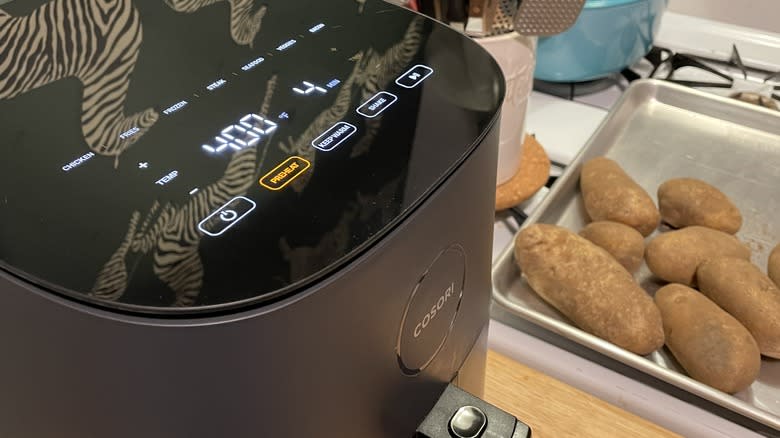
Since we planned on baking the potatoes in both our oven and air fryer at 400 degrees, it was easy to see the difference in how long it took to pre-heat each appliance. The air fryer preheated quickly, in only 4 minutes. The oven, on the other hand, took much longer to heat up — nearly 25 minutes. The oven we used was a traditional radiant heat gas oven. But it's possible that other oven models may take more or less time to preheat. To be sure we were getting the correct temperature, we also relied on an oven thermometer, not just the temperature setting on the oven's dial.
The huge difference in preheating times isn't entirely surprising. First, the air fryer compartment is a much smaller space to heat up compared to the much larger traditional oven space. Also, the air inside of an air fryer is blown around the entire cooking compartment, heating the surfaces and the space faster than a radiant oven. So it's clear that if you're going for speed, the air fryer already has a 21-minute head-start on a traditional oven.
Preparing The Potatoes
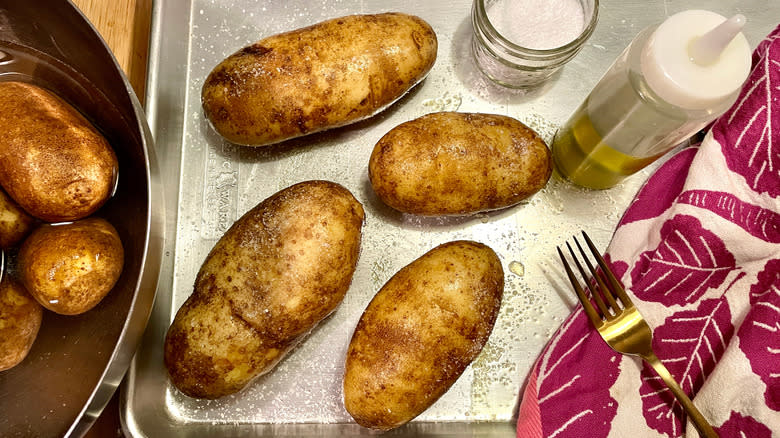
We chose potatoes that were roughly the same size to test in both the oven and the air fryer — each one weighed about 12 ounces. Before cooking, we soaked the potatoes in lightly salted lukewarm water for half an hour, then scrubbed the potatoes clean and dried them. Regardless of which method you choose to cook your potatoes, you still need to prick the potatoes on all sides to vent steam while they cook and avoid any potential potato explosions. After pricking our potatoes with a fork, we lightly rubbed each potato with olive oil and generously salted them on all sides with kosher salt.
In theory, you don't need to oil your potatoes when cooking them in the air fryer since it promises to brown and crisp the skin with its convection heating. But if you want your seasoning to stick to the potatoes, you're going to need to oil them, at least a little bit. If you'd like to use less oil, consider rubbing the potatoes with an oiled paper towel, gently spraying them with cooking spray before putting them in the air fryer, or brushing oil onto the potatoes with a pastry brush. Otherwise, the preparation for your potatoes is the same for cooking in both the oven and the air fryer.
Differences In Cooking Time
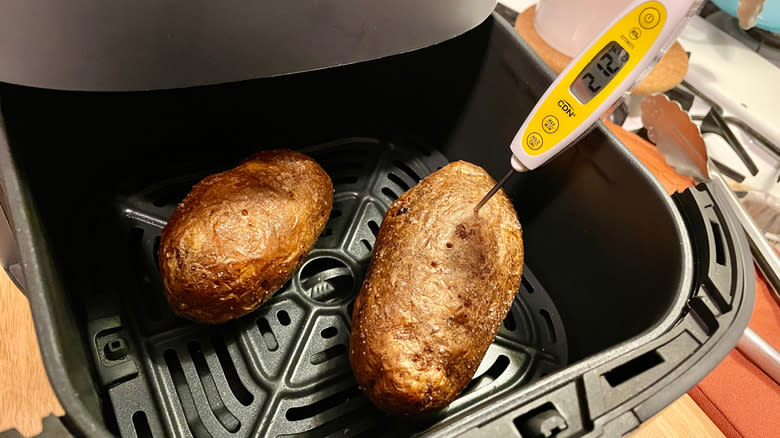
The IPC recommends cooking potatoes in an air fryer for about 30 to 40 minutes, and in an oven for 50 to 60 minutes to reach the desired internal cooking temperature. So we initially set our air fryer to cook for 30 minutes and paused it after 20 minutes had passed, just to turn the potatoes over. After the full 30 minutes, the temperature of the air fryer potatoes had only reached 190, so we cooked them for another 8 minutes to push them past the 210 Fahrenheit mark.
Once our regular oven had finished preheating, we placed the potatoes on a hot baking sheet that had preheated inside the oven and set our timer for 30 minutes again. After 30 minutes, we took the temperature of the potatoes, which had only reached about 175 degrees, flipped them over, and continued baking them for another 20 minutes. After the full 50 minutes, the oven-baked potatoes reached the 210 mark and were pulled from the oven.
The total time to cook the potatoes, including preheating time, was 42 minutes in the air fryer and 1 hour and 15 minutes in the oven. Both methods seem a little long if you're looking for a quick meal, but shaving off more than 30 minutes from the total time is a pretty good step towards getting a meal on the table faster.
Differences In The Potato's Skin
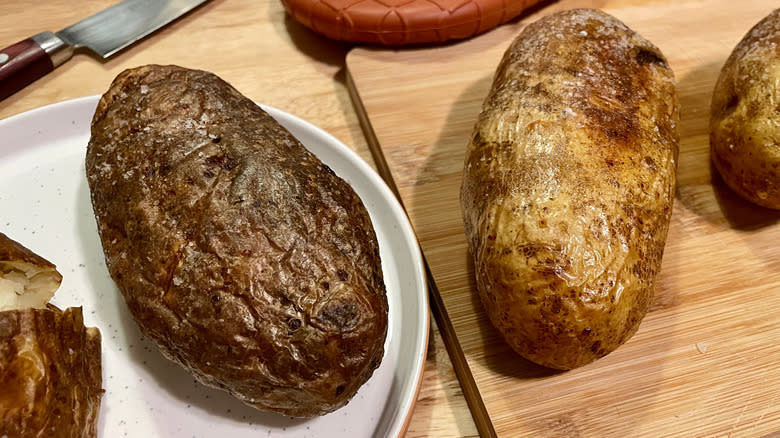
Aside from the reduced time it takes to cook a potato, the biggest advantage that the air fryer claims to offer is an extra crispy finish to all of the foods that would otherwise lack the deep-fried crunch we love so much if baked in the oven. Assuming you didn't wrap your potato in foil to steam cook, the skin of your oven-baked potato will be crisp enough to easily tear apart with a fork after baking and be moderately crunchy as well. Adding oil to the potato's skin is a must to achieve this effect.
However, it was clear during our test that the air fryer-cooked potato had a crunchier skin texture than the oven-baked potato. Not only did it crisp up a little more, but the texture was also noticeably different — like the delicate and crackly tissue paper-like skin on the top of a perfectly baked brownie. The potato also baked a little darker in the air fryer than it did in the oven, even with less time cooking, which is a normal result of cooking foods in convection-style ovens.
After taste-testing each potato, we also noticed that the air fryer baked potato had a slightly more developed roasted skin flavor than the oven-baked potato. It might not be something we'd notice without having tasted both side-by-side. But since we did, we found ourselves more drawn to the richer flavor of the air fryer potato's shell.
Differences In The Interior Texture
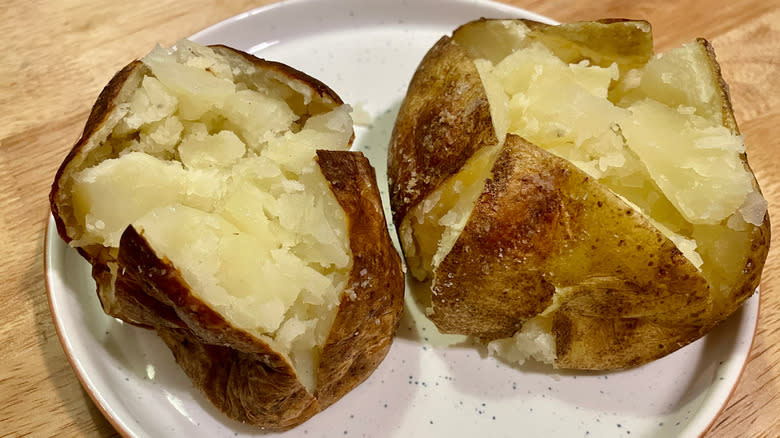
Given the obvious differences in cooking time and skin texture, we thought there might also be a significant difference in the inside texture of the potatoes. But while we noticed a slight difference, it wasn't quite as obvious as the differences between the cooking time, color, and texture of the potato's skin. Each of the potatoes from the oven and air fryer was cooked through according to the internal cooking temperature, as well as a fork-tender test. Both let off a generous amount of steam when split open and easily scooped when it was time to eat. Both potatoes got a pad of butter and a sprinkle of salt and pepper for tasting.
Like the flavor of the potato skins, we might not have noticed any differences in the interior texture of the potatoes unless we were eating them side-by-side. But since we did, we noticed that the potato cooked in the air fryer had a slightly more tender and moist texture than the oven-baked potato. The oven-baked potato split apart fine when we opened it but seemed a little less fluffy and a tad drier (nothing that couldn't be fixed with a little more butter and sour cream, though). Our most educated guess for the slight variation is that the oven-baked potato had to spend more time in the oven to reach the optimal temperature and likely lost a little more liquid in the process.
Do The Potatoes Pick Up Other Flavors From The Air Fryer?
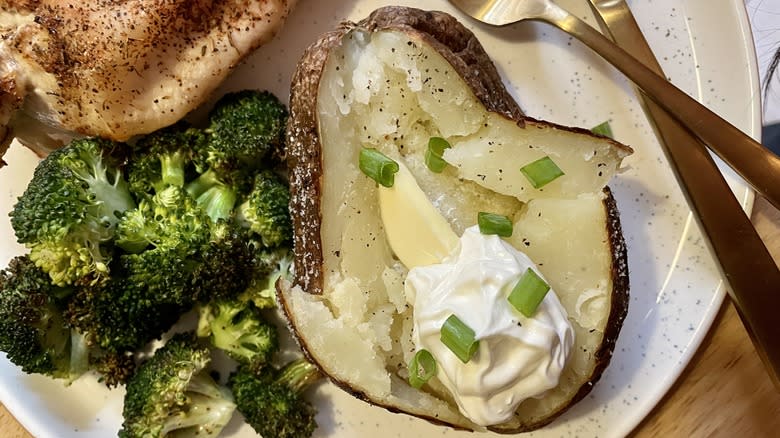
Before testing, we were concerned that the potatoes cooked in the air fryer might pick up other (potentially unenjoyable) flavors from the appliance. Especially at such a high temperature, we weren't sure if there might be a toasted or burnt flavor to the potatoes. Luckily, there wasn't; just the flavor of freshly baked potatoes came through. With that said, if you decide to cook other foods along with your potatoes in the air fryer, there's a chance that the flavors of each of your ingredients may mingle. So just make sure that they are flavors you plan on enjoying together anyway.
Also, to cut down on the potential for any unappetizing burnt or overly-toasted flavors, make sure to avoid using any cooking sprays that might build up on the surfaces of your air fryer over time, as well as low smoke point oils, which will likely burn at the higher temperatures your potatoes will need to cook at.
Cooking Other Food Simultaneously
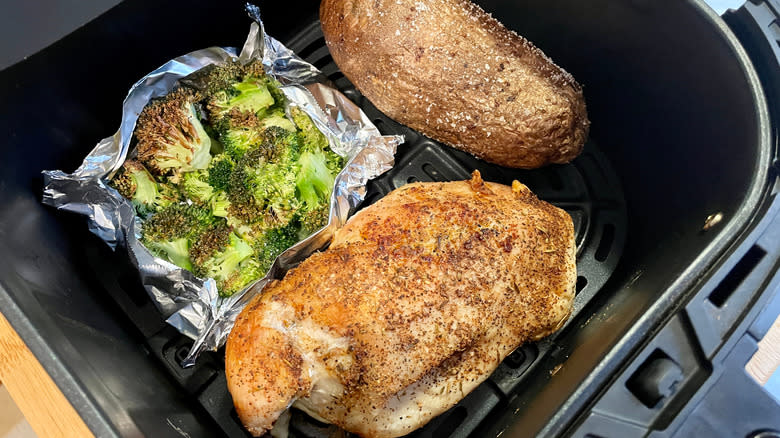
The final thing we considered was how convenient each method is for cooking a complete meal. Generally speaking, a traditional oven with two oven racks will be able to bake a lot more potatoes and several different dishes at the same time. So if you're feeding a crowd, it may actually be more convenient to load your oven up than to cook several rounds of food in the air fryer.
For example, if you're cooking a relatively simple meal of baked potatoes, chicken breasts, and broccoli, your baked potatoes are going to take the longest to bake, regardless of which method you choose, followed by the chicken, with the broccoli needing the least amount of time to cook. If cooked in a traditional oven, all of the food can be cooked in about an hour.
But say you're making the same meal for a family of four in the air fryer. You'll need the first 42 minutes for the potatoes, followed by about 20 minutes for the chicken breasts, and about 10 minutes for the broccoli, which adds up to about an hour and 12 minutes, depending on your machine. So the more people you're cooking for, the less time-efficient the air fryer is. But if you're cooking for one to three people and are able to combine several things to cook at the same time, the air fryer is the more efficient cooking method for a complete meal.
Our Choice For The Best Baked Potatoes
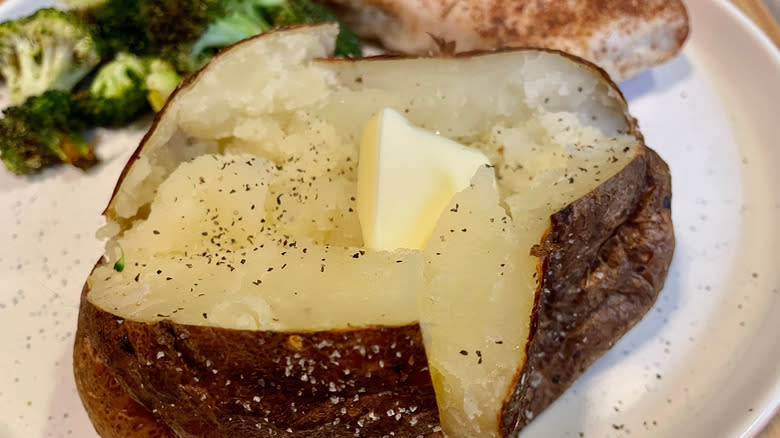
When considering the reduced time it takes for the air fryer to cook whole potatoes in comparison to a traditional oven, it's hard not to opt for the most efficient method of cooking. Even when faced with the prospect of cooking for a handful of people, the compact cooking appliance offers a little extra convenience when it comes to cleaning up by simply putting the fry basket through the dishwasher instead of washing several sheet pans and skillets.
Additionally, the slight flavor advantage also goes to the air fryer, as crispier, more flavorful skin was a better contrast to the slightly more fluffy and moist baked potato interior. For those looking to use less oil in their cooking, it's likely that you'll cut down on the amount of cooking oil needed for an entire meal by using the air fryer as opposed to a traditional oven as well, without sacrificing that deliciously crispy potato skin.
But for bigger dinner parties and holiday meals, we'll probably still opt for the traditional oven method so we can cook a dozen potatoes alongside one or two other dishes in the oven and not have to worry about them while juggling other things. Ultimately, there's no wrong choice here, only a good choice and a better one.
Read the original article on Mashed.

